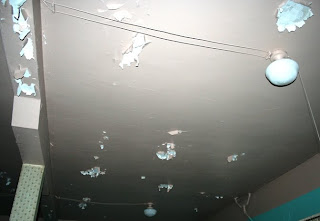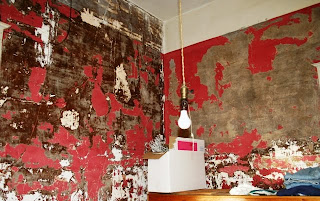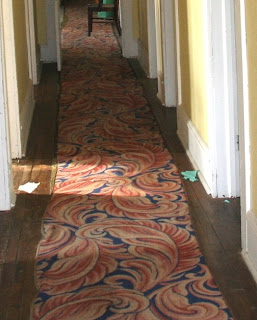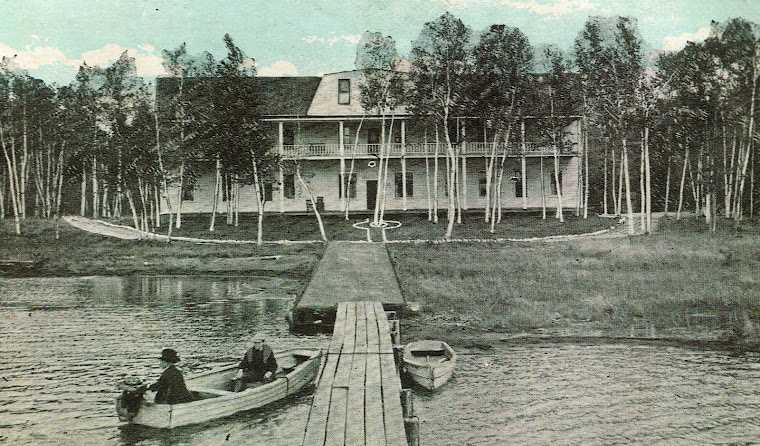

As we get in to the nitty-gritty of bringing the lodge and motel back from the brink of extinction we have a number of decisions to make. Most hinge on how to bring the place up to code and the level of accommodations guests expect, and yet retain the historic character that makes Birch Lodge so special. Last year we worked on the exterior. Our focus now turns to the interior. There are those things we will obviously retain, and there are those that just as obviously we will not. Then there are those in that infamous gray area in between where the decision is not so clear-cut. Here are some of the rehabilitation considerations and issues we face at Birch Lodge. (Please note that the images here are BEFORE views . . .)

The Birch Bar - What a cool place! We hope to keep it as original as possible, although that will probably mean dismantling and reinstalling portions of the back bar and "over-bar" to replace wiring and plumbing, and hopefully not disrupting the birch back wainscoting too much.

We will not be able to salvage the stained and torn funky wallpaper, but hope to find a suitable replacement.


There is a jukebox in the Birch Bar that "almost works" and will need to be repaired, as well as this,a second non-working machine - a Seeburg SelectoMatic 100(!)- that we'd like to restore and return to the bar.

In the main lobby there is an old wood telephone booth. The pay phone was removed a while ago (it worked up into the 1980s). We will retain the booth and have thought about installing a phone there so that guests might experience "phoning home" the old-fashioned way. Word to the wise - this vintage apparatus will not accommodate "plus-size" individuals.

We still are considering how to deal with heating and cooling. The current heating plant, hot water boiler system installed in the 1920s appears beyond salvage. However, whatever we decide, we plan to retain the room radiators to help augment the vintage feel of the place.


The other major infrastructure issue is electrical and wiring. While many of the original light fixtures survive, they are serviced primarily by knob-and-tube dating to the 1920s. We would have had the county building inspector out earlier but we were afraid he might be an older guy who would have had a coronary when he looked around . . . Actually, we are thinking of retaining some of the exposed knob-and-tube after the electrical upgrade - non-functional, of course - as another one of those "little things" that reinforce the vintage feel of the lodge.

The old plaster walls are cracked and some areas of the ceiling have failed. We plan to repair the plaster as much as possible, using plaster washers where necessary, although we may resort to 3/4-inch drywall for ceilings with massive plaster failure.

As for paint - it's not as easily addressed as you might think, aside from the fact that we are going to need some REALLY GOOD primer. A bigger challenge is that most of the walls (and ceilings) are peeling badly (see ceiling in knob-and-tube image above) and Deb's research reveals that this is probably due to applying paint over the original calcimine-based paint. We will need to remove the surface layers AND seal or remove the original calcimine if we want to avoid a repeat.

While the hardwood floors will need to be refinished, they aren't in horrible shape. We'd like to retain the vintage rug runners that line the halls, again for vintage feel, but also functionally to deaden sounds. While the current runner is a colorful "statement" that we hope to reuse, we discovered it overlays an original runner that is a wonderful art nouveau pattern.


The kitchen was renovated during the early 1970s and we're not sure how much upgrading will need to be done there. However, one thing we surely will retain is the former walk-in ice box (now used as a small pantry) complete with its surviving block-and-tackle ice access.

The basement - we don't even want to go there. Literally. But we certainly will not molest the initials and date scribed by one of the lodge construction workers in wet concrete on the basement stairs "W.H.S. 8-27-11".
So, as you can imagine, we will have our hands full. Our objective is to conserve as much as we can - except, unfortunately, when it come to our bank account!








































